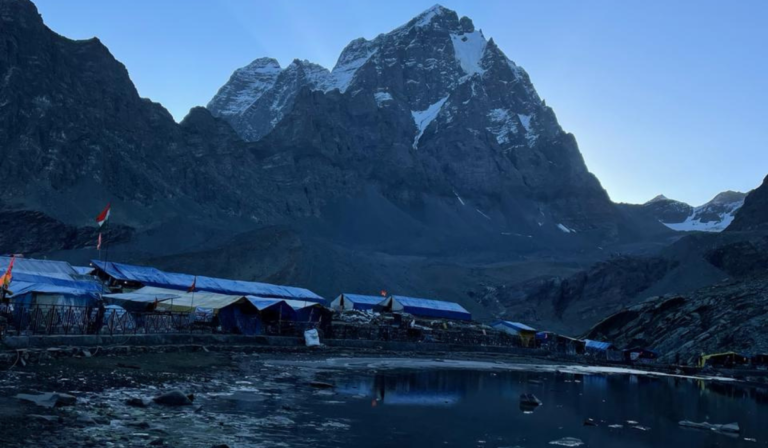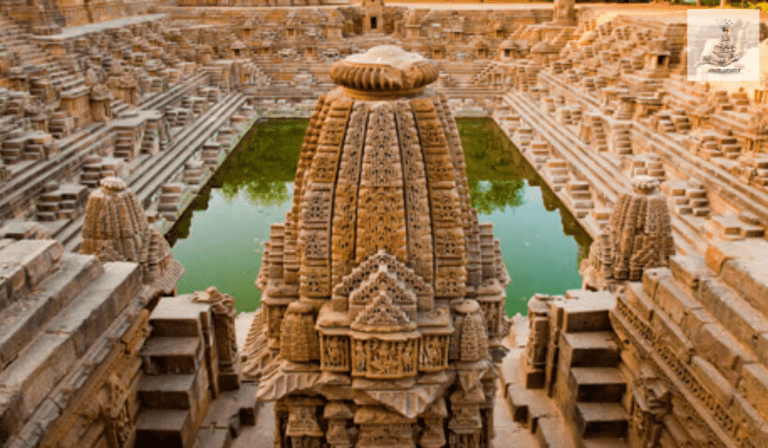Aadi Himani Chamunda Temple| History, Trek, Location, Things to Do!
Aadi Himani Chamunda temple dedicated to Goddess Chamunda sits high up in the mountains [3185m] where snow only starts to melt around March and April giving it its name Aadi Himani. Legend has it that this very place witnesses the battle between the demons Chand Mund and the Devi Durga [Chamunda]. The Nandikeshwar Mahadev temple [within the Chamunda temple complex] is the place from where Devi threw stones at the demons during the battle. There’s still a big rock there, that as said can never fall to the ground due to Shiva presiding at the spot in the form of Lingam.
The main temple, known as Chamunda Nandikeshwar Dham, is located 13 kilometers away from the town of Dharamshala, on the road to Palampur and Mcleodganj.
Dedication and Worship: The Belief
Chamunda is typically depicted as a fearsome goddess with a fierce expression, dark complexion, and multiple arms holding various weapons giving her a terrifying appearance, symbolizing the destruction of evil forces. Devotees represent her in art as being in cremation grounds or near fig trees with traditional offerings of liquor and animal [sacrifices]. In the past, even human sacrifices. Devi has a necklace of skulls, and her attire is adorned with severed heads and other gruesome elements linking her with the fierce goddess Kali and is sometimes identified with Parvati, Chandi or Durga. Devi is also revered in Jainism where worship includes vegetarian offerings instead of meat and liquor.
As Vedic culture has a long history of syncretism and adaptation it is believed that Devi Chamunda was initially a tribal goddess [Munda people] that later got assimilated into it. Similar to the Sheshandev [Kirats] who worship lingam, as referred to by sage Vashist in Rigveda. This particular tribe is known as original or say earlier [to Vedic Aryans] inhabitants of the land [Udubraj] and were defeated after the 40 years of war waged by an Aryan king Divodas. Thus the lingam worship which was absent in earlier Vedic literature [such as Rigveda] became the central part of Vedic tales and Shiva [worshipped as lingam]. The highest God [one of Tridev] is believed to be the result of the assimilation of Kirats in Vedic culture.
The shrine [Chamunda Devi] is believed to be one of 51 Shakti peeth in the subcontinent [6 in Himachal]. Locals believe that the dhad (torso) of Devi Sati fell at the site. Another legend [possibly tribal] tells the story of a fierce battle and eventual defeat [by Devi Chamunda] of the demon brothers Chanda and Munda at the place highlighting Devi’s role as a protector of the local communities.
Aadi Himani Chamunda Trek
After reaching Kangra, catch a shared taxi to Jia village where the trek [7.4 km] officially begins. Make sure to bring plenty of water since there won’t be any water sources along the way. Once you reach the summit, set up your camp for an overnight stay. If trekkers are traveling from another state, they can take a train to Pathankot and, if they have extra time. Consider taking the toy train or a bus to Kangra. The nearest airport is in Kangra.
Important points to remember before trying the Himani Chamunda Trek:
- Two Routes to Himani Chamunda: You have two options to reach Himani Chamunda, but it is recommended to start your trek from Jia village. This could be due to factors like the trail conditions, scenery, or overall trek experience being more favorable from Jia village.
- No Water Along the Way: Similar to the Triund trek, you won’t find any water sources along the route to Himani Chamunda. It’s advisable to carry your own water to ensure you stay hydrated during the trek. The lack of water sources could be due to the terrain or environmental conditions.
- Aadi Himani Chamunda Temple at the End: The ultimate destination of the trek is the Aadi Himani Chamunda temple. As a sign of respect and adherence to cultural norms. It is emphasized that visitors should refrain from bringing any prohibited items to the temple premises. This is likely to maintain the sanctity and respect for the religious site.
- Not a Party Trek: If you’re looking for a trek where you can have a lively and festive atmosphere, this trek may not be suitable for that purpose. The emphasis here is on the trekking experience and the natural surroundings rather than a party atmosphere.
- Limited Mobile Network: There is a lack of mobile network coverage for a significant portion of the trek. This means that communication via mobile phones may be unreliable or impossible in certain areas. This could be due to the remote location or geographical factors affecting signal strength.
- Challenging Sections in the Trek: Some parts of the trek are challenging. This could involve steep ascents, difficult terrain, or other obstacles. Being prepared in advance implies physical conditioning and mental readiness.
- Winter Trek Preparation: If you plan to trek during the winter, it’s strongly recommended to bring specific trekking and snow gear. This could include warm clothing, waterproof boots, and equipment suitable for snowy conditions. Winter treks often require additional preparation due to the harsher weather and potential snow-covered paths.
FAQs
What is the significance of Aadi Himani Chamunda Mandir?
Aadi Himani Chamunda Mandir is dedicated to Goddess Chamunda, a powerful form of the Hindu Divine Mother. The temple has historical importance, as it is said to be the site of a fierce battle between the goddess and the Chand Mund demons.
How can I reach Aadi Himani Chamunda from Kangra?
Start your journey by reaching Kangra. From Kangra, take a shared taxi to Jia village, the starting point of the trek. The trek covers a distance of 7.4 km, and it is recommended to carry ample water, as there are no water sources along the way.
Are there alternative routes to Himani Chamunda?
Yes, there are two routes to Himani Chamunda mandir, but it is advised to start the trek from Jia village for a more favorable experience. Factors such as trail conditions and scenic views may contribute to this recommendation.
Is there water available along the trek route?
No, similar to the Triund trek, there are no water sources along the route to Himani Chamunda. Trekkers are advised to carry their own water to stay hydrated during the journey.
What should I keep in mind before attempting the Himani Chamunda Trek?
It’s important to consider the following:
- Start the trek from Jia village.
- Carry sufficient water due to the lack of water sources.
- Respect cultural norms at the Aadi Himani Chamunda Temple.
- Understand that it’s not a party trek; the emphasis is on the trekking experience.
- Expect limited mobile network coverage.
- Be prepared for challenging sections in the trek.
- If trekking in winter, ensure appropriate gear for snowy conditions.
Can I visit Aadi Himani Chamunda Temple during winter?
Yes, but it’s strongly recommended to bring specific trekking and snow gear for winter treks. This includes warm clothing, waterproof boots, and equipment suitable for snowy conditions.
What are the prohibited items at Aadi Himani Chamunda Temple?
Visitors are advised to refrain from bringing any prohibited items to the temple premises. Specific details about prohibited items can be obtained locally or through reliable sources.







